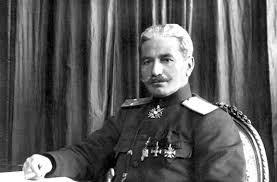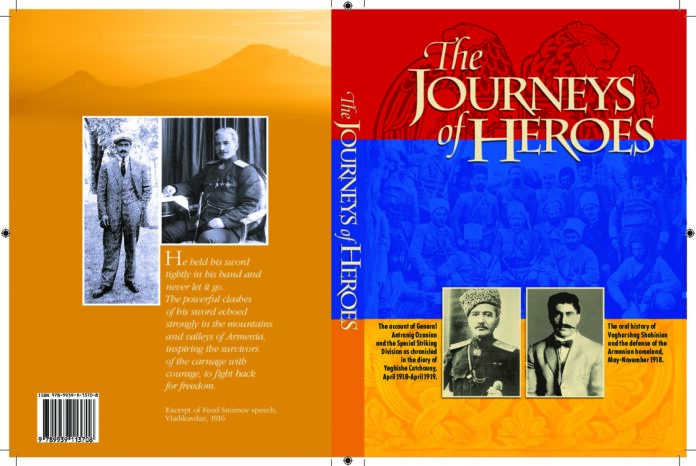FAIR LAWN, N.J. — It is not often that the translation and publication of a family heirloom diary ends up being highly relevant to current events.
In the case of Ken Sarajian and Paul Shahinian, their grandfathers’ stories involved heroic exploits from modern Armenian history which certainly warranted publication, but which were not nearly as topical as they suddenly became once war broke out again with Azerbaijan.
The book, the Journeys of Heroes, was published by the ANI Armenian Research Center in Yerevan, and edited by Tatul Hakobyan, director of the Institute and a journalist and independent political analyst in Armenia. It presents translations of the memoirs of Vagharshag Shahinian, a volunteer fighter from Van, and Yeghishe Catchouny, one of the primary personal aides of General Antranik Ozanian. Both men served in the Caucasus front of WWI during the creation of the First Republic of Armenia in 1918.
Hakobyan is the author of Green and Black: Karabakh Diary (2008), View From Ararat: Armenians and Turks (2012) and most recently Valley of Death: A 44-day Catastrophe (2021). He joined Ken Sarajian (grandson of Yeghishe Catchouny) and Paul Shahinian (grandson of Vagharshag Shahinian) for a book presentation at St. Leon’s Armenian Church on December 9, which was simultaneously broadcast on Zoom and moderated by Ara Araz. The event was cosponsored by the Armenian Democratic Liberal Party (ADL), the Knights of Vartan – Bakradouny Lodge, the National Association for Armenian Studies and Research(NAASR) , the Ararat-Eskijian Museum, the Armenian Network of America – Greater NY, and the families of Vagharshag Shahinian and Yeghishe Catchouny, as well as St. Leon’s.
After an introduction by Araz, there was a discussion by Paul Shahinian, followed by Ken Sarajian, on the contents of the book.

Two Heroes
Vagharshag Shahinian was a young man from Van who had immigrated to America and was working in a foundry in Syracuse, NY. At the outbreak of the First World War, he made his way back to Van, fled with his family to Yerevan, and joined a volunteer military unit. Settling in the US after the Sovietization of Armenia, his adventures were known to grandson Paul Shahinian and other family members but details were murky until a cassette tape was discovered marked simply “1915.” The tape was an interview with Vagharshag which revealed the story of his military service in Armenia.
Shahinian also discussed the story of Yeghishe Catchouny, who was a family friend of the Shahinians. While Catchouny had written down his story and had it published as “Zoravar Antranig – Haygagan Arantzin Harvadzogh Zoramasuh” [General Antranig – The Armenian Special Striking Division], it has not been translated into English. The two families’ search for a translator for these two stories was answered when Hakobyan, who had taken an interest in Catchouny’s original book (published in Western Armenian), approached the Catchouny descendants for a project.
Catchouny was born in Arabkir and studied law in Constantinople. During the war he ended up in the Caucasus, where he acted as “aide-de-camp” to General Antranik, in the words of Shahinian. In his memoir, Catchouny described the events that transpired in his service under Antranik and with the Special Striking Division, a fighting force which defended the First Republic of Armenia but did not always obey orders from the government. When the Armenian leadership made huge concessions to Turkey in the Treaty of Batum, Antranik refused to recognize the Treaty and went rogue, travelling to Zangezur (today’s Syunik) with his men. The Turks would have been given permission to traverse from Nakhichevan to Baku with their military. Antranik put a stop to this by holding the Syunik region with his Special Striking Division.
Much of the historical context of the Karabakh Conflict is brought to light by Catchouny’s story, including the territorial disputes revolving around Karabakh, Nakhichevan, and Syunik, as well as the issue of Pan-Turkism. Great power politics, which at the time prominently featured the British, are also part of this story.
The interesting coincidence in the two stories came from the fact that Vagharshag Shahinian’s “Vanetsi Regiment” was sent to take over the location in Dilijan that Antranik’s group had left. Shahinian, a commander of 200 men, and his friends quickly realized that their mission was fruitless and informed their commander that they too were leaving to join Antranig. Shahinian ended up leading 1,100 men southward to join Antranig, although by the time they arrived in Nakhichevan, Antranig had gone on to Syunik and Karabakh.

Ken Sarajian, a grandson of Yeghishe Catchouny, was next to speak. Speaking as a high school history teacher, Sarajian does not like the phrase “history repeats itself.” Rather, we should look to history to gain insight on what is going on today, he says. He believes his grandfather’s story has an important resonance for what is happening in Artsakh (Karabakh) today, as it describes the territorial conflicts that surrounded Karabakh in the WWI period, which involved much of the same players. To understand why there is a conflict today or what is going on, we need to look at the roots of the issue, he said.
Hakobyan reiterated the importance of the Shahinian and Catchouny stories and their relevance to today’s Artsakh conflict. During the question and answer session, he claimed that the three figures responsible for keeping Syunik part of Armenia are Antranig, Garegin Nzhdeh, and Alexander Miasnikyan (one of the first heads of the Soviet Armenian government). Hakobyan also pointed out how relevant Catchouny’s testimony is, as he did not refrain from criticizing his leader, General Antranig, at times. Hakobyan’s point was that memoirs of everyday people are sometimes considered too biased to be used as an historical source, but Catchouny’s criticism of Antranig showed him to be an extremely honest and trustworthy source as to the events that took place. Hakobyan also noted that much of the account is corroborated by British officials who were present.
The Journeys of Heroes, is available on the NAASR website here: https://naasr.org/products/journeys-of-heroes-the?_pos=1&_sid=2aaedf67e&_ss=r
A translation into Eastern Armenian, as both accounts were originally in Western Armenian, is planned by Hakobyan in the immediate future for publication in Armenia.
by












